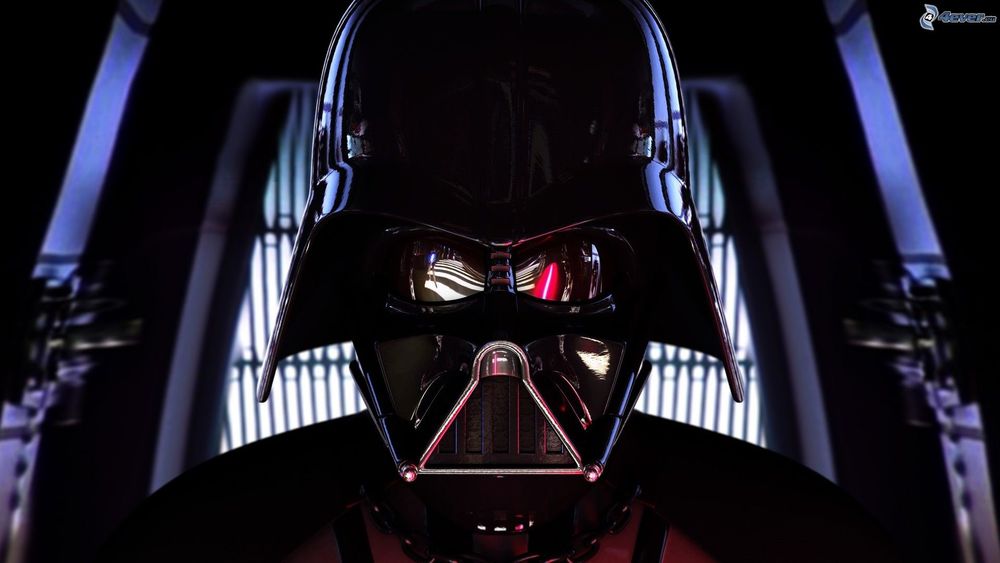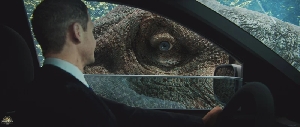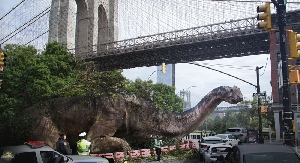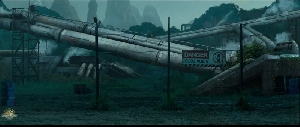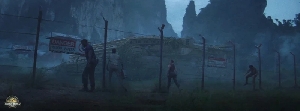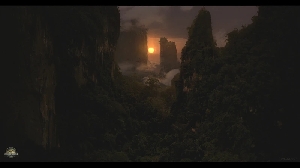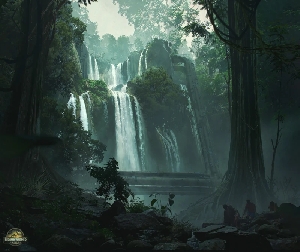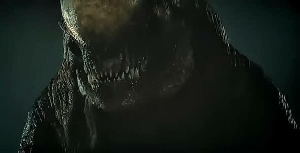Mesozoic Marvels: Episode 4
Dinosaurs Forum Topic

Rex Fan 684
MemberCompsognathusJan 27, 20142353 Views4 Replies230 million years ago, a new group of animals arrived on the scene. Nothing, before or after, were like them. They are perhaps the most extraordinary creatures of all time. The dinosaurs. For 160 million years they dominated the Earth. From as far north as Alaska, to as far south as Antarctica. From the plains of Australia, to the forests of America. The dinosaurs were one of lifes great success stories. Now, take a journey back in time and experience their world. The world of these Mesozoic marvels.

Episode 4
Medieval Monsters
As the sun rises on Europe 125 million years ago, life begins to stir. The planet had experienced a minor extinction about 20 million years earlier. The cause of it is unknown, although the breakup of the continents probably played a role. Across the globe, dinosaurs were quick to recover. This includes Europe. Dinosaurs of all shapes and sizes roam the continent. Some look truly medieval looking. Polacanthus is a prime example.
Polacanthus was an armored brute. At over 15 feet long and 1 ton in weight, they were medium sized nodosaurus. They look fearsome, but are in fact harmless vegetarians. That is unless someone or something threatens them.
Polacanthus is usually a solitary animal. However, it’s the mating season and many of the armored dinosaurs have gathered in one location. The females create a rigid circle and two males enter the “arena” to do battle. The ultimate winner gets first choice of the females. Two large bulls enter the circle and bellow challenges at each other. Then, the two dinosaurs move towards each other and begin to shove back and forth. These shoving matches are a test of pure brute strength and can last for hours. After a good half hour of shoving, the larger of the two manages to drive a shoulder spike into the eye of his rival. The smaller Polacanthus is sent reeling back in pain. The larger bull bellows in victory. He then looks around to see if another male will challenge him. At first, nobody does. Then, another large Polacanthus steps forward. And with that, the barbaric shoving contest continues.
It’s not only the mating season for the Polacanthus. Thousands of giant salmon are migrating into local streams and rivers to breed. The adults measure nearly 6 feet in length! The salmon are nearing the end of their journey. But they have one more major obstacle. A 10 foot high waterfall stands between them and their breeding grounds. And patrolling the falls are some of the greatest fisherman ever. Baryonyx, aka, heavy claw.
![]()
Baryonyx are experts at catching fish. Their long jaws and massive thumb claws are perfect for the job. The spinosaurs are also massive animals. Adults measure over 30 feet long and weigh 2 tons. They over 4 times heavier than the largest grizzly bears.
The Baryonyx begin to form up in preparation for the salmon. The largest individuals get prime spots on the crest of the falls. Younger and smaller animals wait in the pools below. They flex their powerful arms in anticipation of the fish. From their higher vantage point, the largest Baryonyx begin to see the incoming fish. As they approach the falls, some of the smaller spinosaurs lunge and swipe at the fish. Many of the fish escape the clumsy youngsters, but the adults in the pool manage to take a number of fish. One female manages to grab one in her jaws and impale another on her thumb claws simultaneously. She takes the fish to the bank where she is greeted by her two offspring. The salmon are starting to try and jump over the falls. Some are caught in mid-air by the Baryonyx. One large male lunges forward and latches onto a salmon. However, an equally large male has also claimed this fish. The two spinosaurs engage in a tug of war. Eventually, the fish is torn in half and each gets their share. The predators continue to fish for several hours. Many salmon will get passed, but not all. For all their size and ferocity, Baryonyx is not the top predator here. That title belongs to a predator equally as large, but far better equipped for heavy combat. The owner of the title of apex predator is Neovenator.

Neovenator was the top predator of Europe 125 million years ago. At 26-30 feet long and 1-2 tons, it wasn’t any bigger than Baryonyx. However, with 2 inch fangs and 5 inch claws, along with a top speed of 25-30 miles per hour, Neovenator was better equipped for taking down large prey.
A pack of Neovenator are on the hunt. The pack is only 4 members strong, but all of the individuals are large and strong. They’re hunting, but not for prey. Recently, a rival pack has been intruding on their territory. They want to find the pack so they can drive them out. As the pack patrols it’s territory, the find the rival predators. The other Neovenator pack numbers 6 individuals. However, 2 of them are sub-adults with limited experience. The local pack roars at the intruders. The rivals roar back. Rival packs rarely fight. Standoffs like this are usually acts of intimidation. The local pack, known as Alpha Pack, flashes their head crests in vibrant colors. The quill like spines on their necks also raise up in an aggressive manner. The rival pack, Delta Pack, does the same. However, Alpha Pack’s display is the more intimidating of the two. Eventually, Delta Pack backs down. Alpha Pack has held onto their territory.
3 days later and 5 miles away, a mixed herd of dinosaurs feed on the open plains. The smaller of the two species, relatively speaking, is Iguanodon.
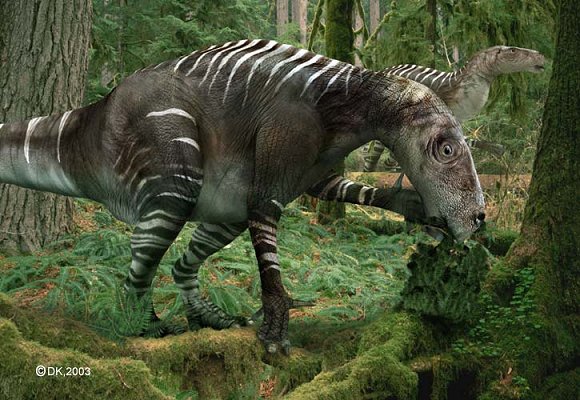
Iguanodon is one of the first dinosaurs ever found and one of the most famous. Adults were nearly 33 feet long and weighed over 4 tons. The elephant sized dinosaurs also had a foot long thumb spike for protection.
The larger of the two is the sauropod Gigantosaurus.

While a large animal, Gigantosaurus was not as large as it’s name might imply. These dinosaurs could still reach an impressive 50 feet long and 10 tons or more when fully grown. As with most sauropods, their long tails made for useful weapons.
As the dinosaurs feed, Alpha Pack begins to stalk them. They have to make a hard choice. Go for the smaller, but better defended Iguanodon or the larger, but less defended, Gigantosaurus. They decide to take a risk and go for the sauropods. Alpha Pack uses their speed and rushes out onto the plains from cover and attacks. The Iguanodon know their best chance at survival is to stand and fight. They make a rough circle around the young and use their thumb spikes to ward off attackers. But the Neovenators aren’t aiming for them. The Gigantosaurus spread out and make a run for it. Alpha Pack zeroes in on an older animal. They easily catch up with the sauropod and surround it. The Gigantosaurus bellows and swings his tail at his attackers. The Neovenators avoid the tail without any problem. One of the pack members rushes in from behind, but receives a nasty surprise. The Gigantosaurus kicks back and smashes the predator in the face with a powerful hind leg. The Neovenator falls to the ground, his skull smashed. With the Gigantosaurus distracted, the rest of the pack leaps into action. They attack from all sides. The Neovenators leap onto the back and sides of the sauropod. Then using their long claws and sharp teeth, they inflict hideous wounds. After only a minute of attacking however, they retreat. The job is done. Blood loss and shock will doom the Gigantosaurus. They just need to wait.
A few hours pass and the Gigantosaurus finally succombs to his injuries. Alpha Pack moves in to feed. They won’t need to hunt again for weeks. Once the Gigantosaurus carcass is finished off, they still won’t hunt. They aren’t above cannibalism and will simply feed on the remains of their dead pack mate.
The cruel and barbaric world of early Cretaceous Europe will soon come to an end. The continent will continue to break up, dividing it into a large system of islands. New predators will rise and dethrone Neovenator and Baryonyx. However, half a world away in Australia, dinosaurs wage their own battle royale down under.
Sorry for this episode being late. I've been very busy lately.
Replies to Mesozoic Marvels: Episode 4
Hey Guest, want to add your say?
Are you an avid Jurassic World fan looking for a dedicated online community of likeminded fans? Look no further! Create your own profile today and take part in our forums and gain XP points for all the content you post!

